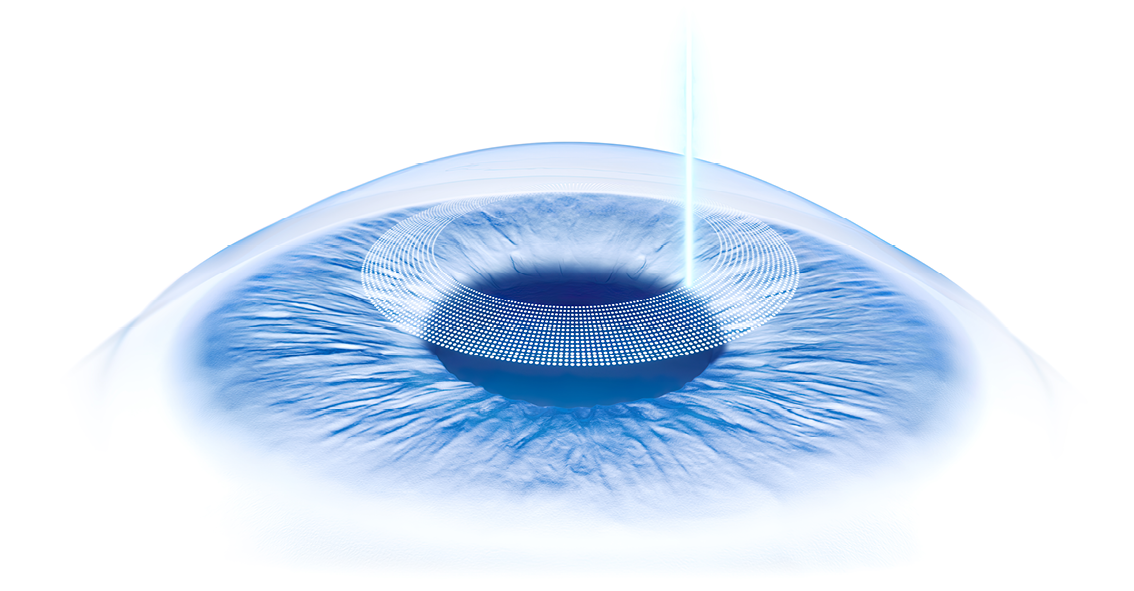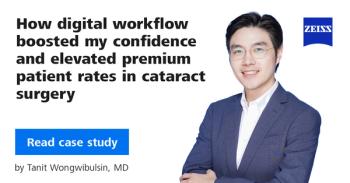
Spectacle independence for presbyopic patients: Achieving success and satisfaction with ZEISS PRESBYOND, even in a highly demanding cohort

Commercial airline pilots work mandates the ability to see clearly at multiple distances from near to far under a variety of conditions. This Case of the Month highlights the impact of prespyopia on visual functions for pilots and that ZEISS PRESBYOND can be a great option to consider improving the ability to perform the full range of their occupational vision-related tasks with high patient satisfaction after surgery.
The reduction in near and intermediate visual acuity (VA) associated with presbyopia presents particular functional challenges for commercial pilots whose work mandates the ability to see clearly at multiple distances from near to far and under a variety of conditions that can create glare and decrease contrast. Highlighting the importance of the impact of presbyopia on visual function for pilots are data indicating that airline pilots are a “graying” population with an average age of about 44 years among European pilots and even older among those in other global regions.1
To achieve medical certification for flying, commercial airline pilots must meet rigorous visual performance standards, including for VA at all distances. ZEISS PRESBYOND® (Carl Zeiss Meditec AG; Jena, Germany) is a binocular corneal approach to manage presbyopia that has the ability to successfully meet the complex visual demands of presbyopic pilots whether hyperopic3, myopic4 or emmetropic5. Performed using a software option for the ZEISS CRS-Master® or ZEISS Refractive Workplace® in combination with the ZEISS MEL® 80 or MEL® 90 excimer laser (all Carl Zeiss Meditec), ZEISS PRESBYOND increases depth of field by inducing a controlled amount of spherical aberration. The surgeon is correcting the dominant eye for far and the non-dominant eye for near, creating an anisometropia of up to 1.5 D, depending on the tolerance of the patient. The result is the creation of a blend zone that affords patients continuous vision over a range of distances. The small inter-eye difference in refraction that is present after ZEISS PRESBYOND is well-tolerated by most individuals and does not affect stereoacuity. Furthermore, because ZEISS PRESBYOND creates a continuous aspheric profile on the cornea rather than multifocality, patients maintain good contrast sensitivity and visual quality. As published in numerous peer reviewed journals, the clinical results achieved with ZEISS PRESBYOND in patients treated at our center and by other surgeons provide evidence that it is a safe, well-tolerated, effective method for treating presbyopia with high accuracy, stability, adjustability and, if needed, reversibility.2-7
Case report
Since 2012, many commercial and military pilots have been treated with ZEISS PRESBYOND at our London Vision Clinic. One of the earliest individuals in this series was Eleanor Ivory, MD, who worked for British Airways as both a commercial airline pilot and Aeromedical Examiner (AME) whose job entails conducting examinations for granting pilot medical certification. Dr Ivory had worn contact lenses to correct myopia since her early teens. Wanting to explore vision correction options other than readers or varifocal glasses for achieving spectacle independence, Dr Ivory presented at age 53 to the London Vision Clinic in 2013. On assessment, her refraction was -3.50 -0.50 x 146 OD and -2.25 -0.75 x 10 OS, and she was deemed an appropriate candidate for a LASIK procedure. After counselling about the risks, benefits, and alternatives, Dr Ivory was treated using ZEISS PRESBYOND software with her dominant right eye targeted for far (plano refraction) and her left eye for near (-1.50 DS).
At 1 month after surgery, Dr Ivory’s binocular uncorrected VA was 20/16-1 at distance, J3 at intermediate, and J1 at near. She received Class 1 medical recertification without glasses restrictions from the United Kingdom Civil Aviation Authority at 8 weeks postop, and review of data collected at return visits over the next 8 years show that her refraction and binocular VA values were stable long-term. Moreover, at 10 years after surgery, Dr Ivory remains exuberant about her outcomes and an ardent advocate for ZEISS PRESBYOND.
Documenting patient satisfaction
Over the years, feedback from the numerous pilots treated with ZEISS PRESBYOND indicates that the recorded VA results correspond with improved ability to perform the full range of their occupational vision-related tasks. However, we wanted to formally document the subjective benefits of ZEISS PRESBYOND for pilots and approached Dr Ivory for help developing a questionnaire. After reviewing the presenting complaints and motivational factors expressed by pilots who had presented for laser refractive surgery assessment, Dr Ivory in collaboration with two other commercial airliner pilots designed a 16-item questionnaire.6
The questionnaire asked pilots to rate their ability or comfort with tasks before surgery with glasses and after surgery without glasses. It was sent to 23 pilots who had undergone ZEISS PRESBYOND at least 12 months earlier and was completed by 18 pilots. All of the responding pilots received Class 1 medical recertification from the UK Civil Aviation Authority within 2 to 8 weeks after ZEISS PRESBYOND, which speaks to the speed of visual recovery after the surgery and the efficacy of the treatment. Notably, all pilots had binocular uncorrected VA of 20/20 or better at distance and J2 or better at near, and 17 of the 18 pilots achieved J5 or better binocular uncorrected intermediate VA. Eleven pilots (61%) achieved medical recertification without any spectacle requirement or restriction, and the others were recertified with a limitation indicating glasses, including a spare pair, shall be kept readily available in the cockpit if required. Notwithstanding the conditions of their certification, 15 of the 18 pilots (83.3%) reported being able to perform 100% of their vision-related tasks without glasses. In addition, analyses of the data collected in the questionnaire showed that the group achieved statistically significant improvements after surgery in their performance of various tasks as well as in eye comfort (Figure 1). An overall satisfaction score calculated from the data also improved, increasing from a mean of 3.32 ± 0.3 before surgery with glasses to 4.57 ± 0.20 after surgery without glasses, which is very close to the best possible score of 5.0.
Conclusion
ZEISS PRESBYOND is a safe, efficient, and effective LASIK-based procedure for providing spectacle-independence to presbyopic patients in the absence of cataract. Results from published studies world-wide show that ZEISS PRESBYOND delivers excellent vision at all distances without causing loss of contrast or dysphotopsia.2-7 In addition, patient-reported outcomes data show high levels of satisfaction, including among pilots who face complex visual demands within a challenging environment.
Knowledge that the results of ZEISS PRESBYOND satisfy pilots who represent a highly demanding group should give refractive surgeons confidence that this binocular LASIK-type procedure can be a great option to consider for the large and growing population of patients who do not yet have cataract and are interested in solutions for their presbyopia.
Reflections of an Aeromedical Examiner “laser eye surgery expert”
By Eleanor Ivory, MD
I began wearing contact lenses to correct myopia at age 14, and the desire not to wear glasses once I became presbyopic prompted me to research laser eye surgery as a solution to requiring reading glasses.
Undergoing PRESBYOND blended LASIK was a life-changing event for me. I was thrilled that after the surgery I was able to see clearly at all distances without glasses, and a decade later, I still have virtually perfect vision without correction.
Using varifocal glasses to manage presbyopia suits many pilots, but wearers of these aids can be challenged to find the right tilt of the head to look through the correct part of the glasses. In contrast, I experience no delay in accommodation between the various focal distances that pilots are required to rapidly transition through.
As clearly highlighted by the results of the pilot survey, freedom from requiring glasses after PRESBYOND has benefit for several routine flight deck tasks. Strikingly, the survey showed a particular impact in the RARE event where a pilot would have to don a flight oxygen mask or smoke hood. A benefit of PRESBYOND in terms of flight safety also became apparent to me after I had the procedure.
Because I personally underwent LASIK, I am considered “the laser eye surgery expert” in my role as an AME. When approached by pilots interested in refractive surgery for presbyopia, I tell them that PRESBYOND has been a miracle procedure for me, and I recommend it without any hesitation.
Dr Ivory has no relevant financial interests to disclose.
References
- Statista. Average age of airline pilots in 2016, by region. https://www.statista.com/ statistics/739969/average-age-of-airline-pilots/#:~:text=Airline%20pilots%20in%20the%20Americas,average%20age%20of%2043.7%20years. Accessed September 25, 2023.
- Russo A, Reinstein DZ, Filini O, et al. Visual and refractive outcomes following laser blended vision with non-linear aspheric micro-anisometropia (PRESBYOND) in myopic and hyperopic patients. J Refract Surg. 2022;38(5):288-297.
- Reinstein DZ, Couch DG, Archer TJ. LASIK for hyperopic astigmatism and presbyopia using micromonovision with the Carl Zeiss Meditec MEL80 platform. J Refract Surg. 2009;25(1):37-58.
- Reinstein DZ, Archer TJ, Gobbe M. LASIK for Myopic Astigmatism and presbyopia using onlinear aspheric micro-monovision with the Carl Zeiss Meditec MEL 80 platform. J Refract Surg. 2011;27(1):23-37.
- Reinstein DZ, Carp GI, Archer TJ, Gobbe M. LASIK for the correction of presbyopia in emmetropic patients using aspheric ablation profiles and a micro-monovision protocol with the Carl Zeiss Meditec MEL80 and VisuMax. J Refract Surg. 2012; 28:531-541.
- Reinstein DZ, Ivory E, Chorley A, et al. PRESBYOND Laser Blended Vision LASIK in commercial and military pilots requiring class 1 medical certification. J Refract Surg. 2023;39(1):6-14.
- Ganesh S, Brar S, Gautam M, Sriprakash K. Visual and refractive outcomes following laser blended vision using on-linear aspheric micro-monovision. J Refract Surg. 2020;36(5):300-307.
Professor Dan Z. Reinstein, MD MA(Cantab) FRCSC DABO FRCOphth FEBO is Medical Director of the London Vision Clinic, London, England. He is a consultant for Carl Zeiss Meditec AG (Jena, Germany) and has a contractual or other financial relationship with Carl Zeiss Meditec AG and its affiliates and has received financial support.
Newsletter
Get the essential updates shaping the future of pharma manufacturing and compliance—subscribe today to Pharmaceutical Technology and never miss a breakthrough.








































